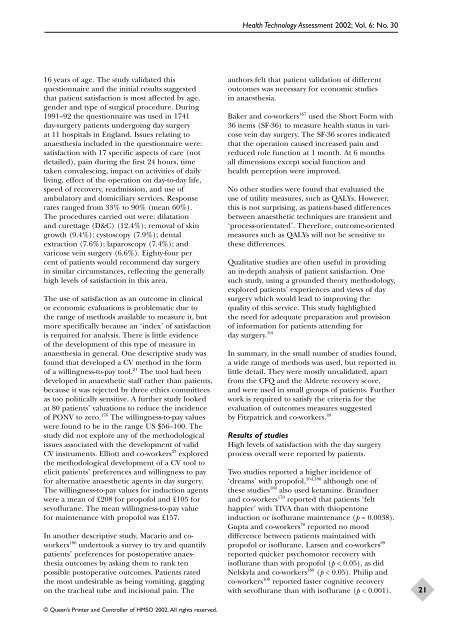Aanesthetic Agents for Day Surgery - NIHR Health Technology ...
Aanesthetic Agents for Day Surgery - NIHR Health Technology ...
Aanesthetic Agents for Day Surgery - NIHR Health Technology ...
You also want an ePaper? Increase the reach of your titles
YUMPU automatically turns print PDFs into web optimized ePapers that Google loves.
16 years of age. The study validated this<br />
questionnaire and the initial results suggested<br />
that patient satisfaction is most affected by age,<br />
gender and type of surgical procedure. During<br />
1991–92 the questionnaire was used in 1741<br />
day-surgery patients undergoing day surgery<br />
at 11 hospitals in England. Issues relating to<br />
anaesthesia included in the questionnaire were:<br />
satisfaction with 17 specific aspects of care (not<br />
detailed), pain during the first 24 hours, time<br />
taken convalescing, impact on activities of daily<br />
living, effect of the operation on day-to-day life,<br />
speed of recovery, readmission, and use of<br />
ambulatory and domiciliary services. Response<br />
rates ranged from 33% to 90% (mean 60%).<br />
The procedures carried out were: dilatation<br />
and curettage (D&C) (12.4%); removal of skin<br />
growth (9.4%); cystoscopy (7.9%); dental<br />
extraction (7.6%); laparoscopy (7.4%); and<br />
varicose vein surgery (6.6%). Eighty-four per<br />
cent of patients would recommend day surgery<br />
in similar circumstances, reflecting the generally<br />
high levels of satisfaction in this area.<br />
The use of satisfaction as an outcome in clinical<br />
or economic evaluations is problematic due to<br />
the range of methods available to measure it, but<br />
more specifically because an ‘index’ of satisfaction<br />
is required <strong>for</strong> analysis. There is little evidence<br />
of the development of this type of measure in<br />
anaesthesia in general. One descriptive study was<br />
found that developed a CV method in the <strong>for</strong>m<br />
of a willingness-to-pay tool. 21 The tool had been<br />
developed in anaesthetic staff rather than patients,<br />
because it was rejected by three ethics committees<br />
as too politically sensitive. A further study looked<br />
at 80 patients’ valuations to reduce the incidence<br />
of PONV to zero. 176 The willingness-to-pay values<br />
were found to be in the range US $56–100. The<br />
study did not explore any of the methodological<br />
issues associated with the development of valid<br />
CV instruments. Elliott and co-workers 33 explored<br />
the methodological development of a CV tool to<br />
elicit patients’ preferences and willingness to pay<br />
<strong>for</strong> alternative anaesthetic agents in day surgery.<br />
The willingness-to-pay values <strong>for</strong> induction agents<br />
were a mean of £208 <strong>for</strong> propofol and £105 <strong>for</strong><br />
sevoflurane. The mean willingness-to-pay value<br />
<strong>for</strong> maintenance with propofol was £157.<br />
In another descriptive study, Macario and coworkers<br />
186 undertook a survey to try and quantify<br />
patients’ preferences <strong>for</strong> postoperative anaesthesia<br />
outcomes by asking them to rank ten<br />
possible postoperative outcomes. Patients rated<br />
the most undesirable as being vomiting, gagging<br />
on the tracheal tube and incisional pain. The<br />
© Queen’s Printer and Controller of HMSO 2002. All rights reserved.<br />
<strong>Health</strong> <strong>Technology</strong> Assessment 2002; Vol. 6: No. 30<br />
authors felt that patient validation of different<br />
outcomes was necessary <strong>for</strong> economic studies<br />
in anaesthesia.<br />
Baker and co-workers 167 used the Short Form with<br />
36 items (SF-36) to measure health status in varicose<br />
vein day surgery. The SF-36 scores indicated<br />
that the operation caused increased pain and<br />
reduced role function at 1 month. At 6 months<br />
all dimensions except social function and<br />
health perception were improved.<br />
No other studies were found that evaluated the<br />
use of utility measures, such as QALYs. However,<br />
this is not surprising, as patient-based differences<br />
between anaesthetic techniques are transient and<br />
‘process-orientated’. There<strong>for</strong>e, outcome-oriented<br />
measures such as QALYs will not be sensitive to<br />
these differences.<br />
Qualitative studies are often useful in providing<br />
an in-depth analysis of patient satisfaction. One<br />
such study, using a grounded theory methodology,<br />
explored patients’ experiences and views of day<br />
surgery which would lead to improving the<br />
quality of this service. This study highlighted<br />
the need <strong>for</strong> adequate preparation and provision<br />
of in<strong>for</strong>mation <strong>for</strong> patients attending <strong>for</strong><br />
day surgery. 191<br />
In summary, in the small number of studies found,<br />
a wide range of methods was used, but reported in<br />
little detail. They were mostly unvalidated, apart<br />
from the CFQ and the Aldrete recovery score,<br />
and were used in small groups of patients. Further<br />
work is required to satisfy the criteria <strong>for</strong> the<br />
evaluation of outcomes measures suggested<br />
by Fitzpatrick and co-workers. 49<br />
Results of studies<br />
High levels of satisfaction with the day surgery<br />
process overall were reported by patients.<br />
Two studies reported a higher incidence of<br />
‘dreams’ with propofol, 164,180 although one of<br />
these studies 180 also used ketamine. Brandner<br />
and co-workers 170 reported that patients ‘felt<br />
happier’ with TIVA than with thiopentone<br />
induction or isoflurane maintenance (p = 0.0038).<br />
Gupta and co-workers 78 reported no mood<br />
difference between patients maintained with<br />
propofol or isoflurane. Larsen and co-workers 89<br />
reported quicker psychomotor recovery with<br />
isoflurane than with propofol (p < 0.05), as did<br />
Nelskyla and co-workers 189 (p < 0.05). Philip and<br />
co-workers 108 reported faster cognitive recovery<br />
with sevoflurane than with isoflurane (p < 0.001).<br />
21
















